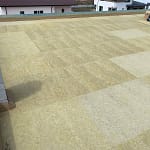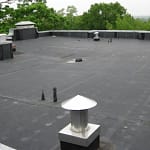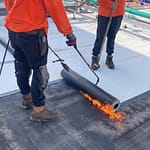Rain drainage in flat roofs is essential for efficient drainage and ensuring the longevity of the building.
Drainage of rain from a flat roof
Drainage of rain from a flat roof is an important technical solution to ensure the protection of the building against water damage and the long-term preservation of the roof structure. In this article, we will discuss the essential aspects and options related to the drainage of rain from flat roofs, including the materials used, construction details, the installation process and the most important technical requirements.
6 steps
rain drainage from a flat roof
When designing flat roofs, one of the most important aspects is rainwater management. The structure of flat roofs is not as sloping as pitched roofs, so the natural drainage of water is more difficult. Without a proper rain drainage system, roof drainage can be inadequate, which can lead to roof damage, moisture ingress into the building, and ultimately higher repair costs.
a) Rain pipes
The main element of rain drainage is a pipe through which water is collected and drained from the roof. Metal pipes (such as galvanized steel or aluminum pipes) or PVC pipes are commonly used. The choice of material depends on specific design requirements, building roof structure and surrounding conditions.
b) Security elements
The rain drainage system also uses various protective elements such as rain gutters, threaded injections and other details that help ensure smooth water drainage and prevent water from spreading around the roof structure.
a) Necessity of separation from the building
It is important that rainwater pipes are adjusted so that water is directed away from the building. This protects the foundations of the building from unnecessary moisture and increases the longevity of the building.
b) Optimal number and position of tubes
Depending on the size and shape of the roof, different numbers and positions of downspouts may be required. During design, calculations are made to choose the optimal number and position of pipes, ensuring efficient water drainage.
c) Integration of the system into the roof covering
During the installation of the rain drainage system, it is important to pay attention to its integration into the roof covering. This includes properly securing the pipes to the roof covering and tight leakproofing to prevent water from pooling or injecting into the roof trusses.
(a) Building codes and regulation
Every country has laws and regulations that govern building roof structures and rain drainage systems. When designing or renovating a roof, it is important to comply with national building codes and standards that set minimum requirements for drainage efficiency and safety.
(b) Renewal and Maintenance Requirements
In addition to the construction requirements, it is also important to follow the recommendations for the maintenance of the rain drainage system. Periodic inspection and maintenance is required to ensure system efficiency and longevity. This includes checking the condition of pipes and protective elements, removing and replacing them if necessary.
Rainwater drainage systems also have ecological and economic benefits. Effective water management helps prevent soil erosion and protects local water bodies from pollution. In addition, a properly designed and installed rain drainage system can reduce building maintenance and repair costs, thus increasing its longevity.
Rain drainage from a flat roof is an important element of roof design that not only protects the building from water leakage, but also contributes to its durability and efficiency. When designing a rainwater drainage system, it is important to consider the choice of materials, structural details, technical requirements and national standards to achieve the best possible result. A properly installed rain drainage system not only protects the building from water damage, but also contributes to environmental protection and the efficiency of economic resources.






